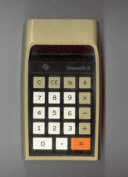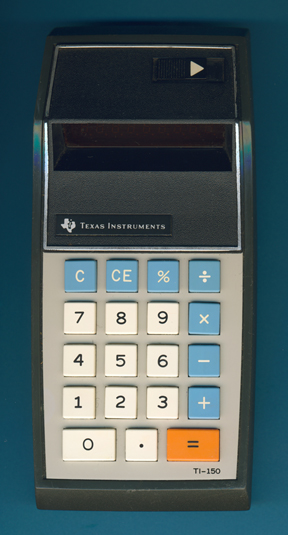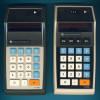
DATAMATH CALCULATOR MUSEUM
 |
DATAMATH CALCULATOR MUSEUM |
Texas Instruments TI-150
| Date of introduction: | December 1974 | Display technology: | Panaplex Style |
| New price: | Display size: | 8 + Sign | |
| Size: | 6.5" x 3.2" x 1.8" 165 x 80 x 45 mm3 |
||
| Weight: | 7.9 ounces, 225 grams | Serial No: | 150-016742 |
| Batteries: | 4*AA Alkaline | Date of manufacture: | mth 11 year 1974 |
| AC-Adapter: | AC9150 | Origin of manufacture: | USA |
| Precision: | 8 | Integrated circuits: | TMS0852 |
| Logic: | Chain | Displays: | DIS-PS9 |
| Memories: | |||
| Program steps: | Courtesy of: | Joerg Woerner | |
| Download manual: | |

![]()
![]()
![]()
 Texas
Instruments introduced with this TI-150 in December 1974 a rather unusual
calculator combining the wedge-shaped housing of the
TI-2550 with the basic functionality of the Datamath II a.k.a.
TI-2500-II and a
Panaplex Style gas-discharge
display. A small detail reveals the position of the TI-150 in Texas Instruments'
"Basic Calculator Portfolio": The silver trim around the display frame, known
from the first generation of the SR-10,
placed it obviously in the upper-right corner of the price over performance
chart.
Texas
Instruments introduced with this TI-150 in December 1974 a rather unusual
calculator combining the wedge-shaped housing of the
TI-2550 with the basic functionality of the Datamath II a.k.a.
TI-2500-II and a
Panaplex Style gas-discharge
display. A small detail reveals the position of the TI-150 in Texas Instruments'
"Basic Calculator Portfolio": The silver trim around the display frame, known
from the first generation of the SR-10,
placed it obviously in the upper-right corner of the price over performance
chart.

 The
Date code
465 stamped on the backside of the featured TI-150 would indicate a manufacturing date in week
46 of November in the year
1975, to our understanding rather unlikely.
We assume that this calculator was serviced in November 1975.
The
Date code
465 stamped on the backside of the featured TI-150 would indicate a manufacturing date in week
46 of November in the year
1975, to our understanding rather unlikely.
We assume that this calculator was serviced in November 1975.

 Dismantling this TI-150
manufactured in November 1974 reveals a design centered
around a TMS0852 single-chip calculator circuit compared to e.g. the
TMS0803 located in the TI-2500-II. Please
notice the Date code 7443 (third week of October 1974) printed on the TMS0852.
Dismantling this TI-150
manufactured in November 1974 reveals a design centered
around a TMS0852 single-chip calculator circuit compared to e.g. the
TMS0803 located in the TI-2500-II. Please
notice the Date code 7443 (third week of October 1974) printed on the TMS0852.
The TMS0852 found its way with slightly
modifications into the Canon Palmtronic LD-series. Don't miss the LD-80.
![]()
 The TMS0852 chip is complemented on the main printed circuit board (PCB) by
discrete transistors to drive the high-voltage gas-discharge display and a power
supply.
The TMS0852 chip is complemented on the main printed circuit board (PCB) by
discrete transistors to drive the high-voltage gas-discharge display and a power
supply.
 The keyboard PCB of the TI-150 is identical to the TI-2550 but lacks the
upper row of keys for the Memory functions.
The keyboard PCB of the TI-150 is identical to the TI-2550 but lacks the
upper row of keys for the Memory functions.

 Update (September 2024): On our quest to
Record the ROM
Content of the TMS0852 single-chip calculator circuit, we salvaged one of our
TI-150 calculators (Yes, they are rare...) and studied its electronic circuitry
completely. Disassembling the donor calculator with serial number #16294 and
manufactured in November 1974 in Texas, resulted in three surprises:
Update (September 2024): On our quest to
Record the ROM
Content of the TMS0852 single-chip calculator circuit, we salvaged one of our
TI-150 calculators (Yes, they are rare...) and studied its electronic circuitry
completely. Disassembling the donor calculator with serial number #16294 and
manufactured in November 1974 in Texas, resulted in three surprises:
|
• The Panaplex Style display was manufactured by Texas Instruments • The display driver uses the -35 Volt-tolerant output drivers of the TMS0850 Product Family for the digits • Texas Instruments disabled the battery-saving feature of the TMS0852 chip |
Calculating Unit: The TMS0852 is closely related to the TMS0800 Product Family and tracing back to the TMS1802NC, the first available standard calculator building block on a chip, later renamed into TMS0102. The TMS0800 kept the size of the Instruction ROM (Read-Only Memory), but decreased the Data Memory from 13 Digits Registers to 11 Digit Registers and added both integrated Segment Drivers for Light Emitting Diode (LED) displays and a clock generator. The TMS0850 Product Family uses redesigned segment and digit output drivers, directly interfacing with low-voltage Vacuum Fluorescent Displays (VFDs) up to 35 Volts and features modified keyboard scanning inputs that can withstand up to 35 Volts.
With low-cost battery operated LED calculators in mind, Texas Instruments added a so-called Timeout feature to the TMS0850 devices. When no key presses are detected for about 20 seconds, the display blanks out and shows only a '-' in the leftmost digit to reduce power consumption of the calculator. Looking closely at the printed circuit board (PCB) traces of the donor TI-150, you'll recognize that Pin 10 (WDK) and Pin 8 (KN) are connected to effectively disable the Timeout feature. Desoldering the TMS0852 from the PCB and operating it with the Timeout feature enabled, results in a big surprise! The display stayed on, even after 5 minutes without any key presses.
![]() Display: The
TI-150 donor calculator manufactured
in November 1974 makes use of a 9-Digit Panaplex Style
7-Segment display assembly manufactured by Texas Instruments. Here at the
Datamath Calculator Museum we refer to this display as "DIS-PS9" till we learn
about its actual part number. Burroughs developed the original Panaplex
technology around 1970 as an alternative to Nixie or cold cathode displays, but
the breakthrough came with the introduction of the second generation products,
commonly known as Panaplex II numerical displays. Panaplex Style displays are
using a hermetically tight sandwich construction filled with neon gas with thin
and nearly transparent anodes for each digit below the top glass. The cathodes
are printed in thickfilm technology with a conductive material direct on the
ceramics substrate. If a voltage of typically around 180 Volts is applied
between a segment and its cathode, the neon gas begins to glow in a warm orange.
A mounting frames holds the Panaplex Style display and secures the 19 clamped
pins connecting it to the Main-PCB. The injection molded plastic frame of the
display module from the featured TI-150 calculator misses the typical stamped
drawing number and bears instead a hand-scribed "TI 1030983" document number.
Display: The
TI-150 donor calculator manufactured
in November 1974 makes use of a 9-Digit Panaplex Style
7-Segment display assembly manufactured by Texas Instruments. Here at the
Datamath Calculator Museum we refer to this display as "DIS-PS9" till we learn
about its actual part number. Burroughs developed the original Panaplex
technology around 1970 as an alternative to Nixie or cold cathode displays, but
the breakthrough came with the introduction of the second generation products,
commonly known as Panaplex II numerical displays. Panaplex Style displays are
using a hermetically tight sandwich construction filled with neon gas with thin
and nearly transparent anodes for each digit below the top glass. The cathodes
are printed in thickfilm technology with a conductive material direct on the
ceramics substrate. If a voltage of typically around 180 Volts is applied
between a segment and its cathode, the neon gas begins to glow in a warm orange.
A mounting frames holds the Panaplex Style display and secures the 19 clamped
pins connecting it to the Main-PCB. The injection molded plastic frame of the
display module from the featured TI-150 calculator misses the typical stamped
drawing number and bears instead a hand-scribed "TI 1030983" document number.
Display Driver: Multiplexed Panaplex Style displays are
using a common anode layout for its digits with all segments (cathodes) bussed
together and fire at a voltage much higher than 35 Volts, the maximum voltage
allowed at the outputs of the TMS0850 single-chip calculators circuit. The PCB
of the TI-150 calculator consequently uses a large amount of real estate not
only for high-voltage generation but adequate display drivers, too. Texas
Instruments chose to connect the digit driver outputs of the TMS0852 chip
directly to the anodes of the display while its segment outputs use level
shifters to a voltage of almost -200 Volts. Analyzing the circuitry of these
level shifters consisting of one PNP bipolar junction transistor (BJT), three
resistors and one high-voltage capacitor per segment channel, reveals a typical
approach with a "voltage doubler". With these designs a capacitor is
pre-charged to around -100 V and to activate the segment, the capacitor is
connected to a bias voltage of -100 V, resulting - while the electron storage lasts in the
capacitor - to a voltage of -200 V, enough to fire the corresponding segment.
All other digits are not selected by the TMS0852 digit driver outputs and hence
stay dim.
Clock: The
TI-150 makes use of the internal clock
oscillator of the TMS0850 chip, we identified a resistor with 150k Ohm connected
between Pin 14 (REXT/Clock Select) of the TMS0852 and the negative
power supply line, resulting in a clock frequency of about of
160 kHz.
Power Supply: The TI-150 calculator is powered with four disposable AA-sized 1.5 Volt batteries and uses a simple DC/DC converter to generate a total of three voltages:
|
• VDD/VGG - Negative supply for TMS0851 (-15.1 V) • VPP - Negative supply for Panaplex Style anodes (-34.0 V) • VHV - Negative supply for Panaplex Style cathodes and capacitor bias (-100 V) |
We measured the operating current of featured dismantled TI-150 calculator:
| Mode | Display | Current VBAT = 6.0 V |
Clock Frequency |
| Calculating | 0. | 100 mA | 160 kHz |
| Calculating | 88888888. | 112 mA | 160 kHz |
Calculating the power consumption at 6 Volts for the TI-150 results in about 300 mW displaying a '0.' and about 340 mW with all segments but the minus sign illuminated. Not very impressive, a Canon LE-84 calculator using four disposable 1.5 Volt Alkaline batteries and a DC/DC converter for its TMS0801 chip clocks in at around 100 mW displaying a '0.' and 320 mW with all segments lit.
Keyboard: The keyboard assembly of the of the TI-150 uses the proved Klixon™ hermetic miniature and sub-miniature snap action switches developed already in 1960. The Keyboard-PCB is connected with 13 stamped metal connectors to the Main-PCB.
 With
the DCM-50A Platform developed to
Characterize and
Reverse-engineer
Single-chip Calculator Circuits we could proof that the TMS0855 uses very
similar
Program Code
to the TMS0803 known from the
TI-1500 or
TI-2550-II but removed the
Timeout feature completely.
With
the DCM-50A Platform developed to
Characterize and
Reverse-engineer
Single-chip Calculator Circuits we could proof that the TMS0855 uses very
similar
Program Code
to the TMS0803 known from the
TI-1500 or
TI-2550-II but removed the
Timeout feature completely.
 This is for calculator collectors the most important question -
and the TI-150 seems to be pretty rare. Texas Instruments spent a fortune to develop this oddball in its
calculator line (unique TMS0852 single-chip calculator circuit, miniaturized
Panaplex Style gas-discharge display, unique AC9150 AC-Adapter) but left the
design of the sales packaging unfinished.
This is for calculator collectors the most important question -
and the TI-150 seems to be pretty rare. Texas Instruments spent a fortune to develop this oddball in its
calculator line (unique TMS0852 single-chip calculator circuit, miniaturized
Panaplex Style gas-discharge display, unique AC9150 AC-Adapter) but left the
design of the sales packaging unfinished.
Roger Whitaker, Lead Engineer of the
TI-150 confirmed an estimated number of about 4,000 produced units:
The TI-150 was the only handheld to use a plasma display. It has a character height of 0.2 inch and was intended as an "Executive" calculator. The case was the TI-2550's. The comments on Joerg's page are basically correct. It lacked the memory feature and was over priced. The production figure of 4,000 is probably right, although I wonder if they actually sold that many. It definitely was the wrong calculator at the wrong time. The plasma display requires about 150 volts to fire the segments. The TMS0855 is probably similar to the TMS0852 in having relatively high voltage display drive output architecture, but driving the plasma display required use of separate discrete high voltage PNP transistors, 2N5400 or 2N5401's as I recall without opening up my TI-150 to look. My 150 is Serial Number 010038 which was a prototype. Something else that most people may not know is that TI made its own plasma displays at a plant in Sherman. They were a direct replacement for the Burroughs Panaplex. I think that my TI-150 may have one of them. They also made the larger ones for the desktop units, too.
And in case you think the TI-150 is rare - how about a TI-150 Prototype?
Fellow collectors - if you own a Texas Instruments TI-150 calculator, please report us the serial number and date code from the back of the calculator (optionally from the TMS0852 calculator chip) for our Database.
|
Texas Instruments TI-150 |
|||
| Serial Number |
Date Code TI-150 |
Date Code TMS0852 |
Owner |
| 001148 | ? | ? | Anonymous |
| 004258 | ? | ? | Anonymous |
| 004300 | wk 49 yr 74 | 7443-1 | Branan Riley |
| 004625 | ? | ? | Jason Baucom |
| 004693 | ? | ? | Ken H. Meine |
| 004862 | ? | ? | Christa J. Anderson |
| 004894 | wk 48 yr 74 | ? | eBay stepgan37 |
| 005040 | ? | ? | Ken H. Meine |
| 005920 | ? | ? | Anonymous |
| 006013 | wk 50 yr 74 | ? | Robbo Suave |
| 006953 | ? | ? | Anonymous |
| 007108 | ? | ? | Anonymous |
| 007189 | ? | ? | Ken Meeks |
| 007206 | wk 50 yr 74 | ? | eBay Milosancho's Store |
| 007486 | wk 50 yr 74 | ? | Cleo McCall |
| 007711 | wk 48 yr 74 | ? | eBay Milosancho's Store |
| 007864 | wk 50 yr 74 | ? | eBay Suncoast Cellular |
| 007901 | wk 50 yr 74 | 7444-1 | Thomas Brockmeier |
| 008085 | ? | ? | Scott Reynolds |
| 008428 | ? | ? | Anonymous |
| 008977 | ? | ? | eBay shawnanderson12345 |
| 009235 | ? | ? | Scott Reynolds |
| 009319 | ? | ? | Scott Reynolds |
| 009342 | ? | ? | Anonymous |
| 009359 | ? | ? | Anonymous |
| 009499 | ? | ? | Scott Reynolds |
| 009600 | ? | ? | eBay ebhospace |
| 009629 | ? | ? | Scott Reynolds |
| 009649 | ? | ? | Scott Reynolds |
| 009720 | ? | ? | eBay towndvd |
| 009814 | ? | ? | eBay highdesertstamps |
| 009830 | ? | ? | eBay joenlain |
| 010038 | ? | ? | Roger Whitaker |
| 011042 | wk 50 yr 74 | ? | Scott Reynolds |
| 011147 | wk 50 yr 74 | ? | eBay laeh |
| 011150 | wk 50 yr 74 | ? | Joe Lewandowski |
| 011257 | ? | ? | Anonymous |
| 011326 | ? | ? | Anonymous |
| 011821 | ? | ? | Anonymous |
| 016262 | ? | ? | Brendon Loyd |
| 016294 | wk 49 yr 74 | 7445-1 | Joerg Woerner |
| 016297 | ? | ? | eBay mu89stang3 |
| 016511 | wk 49 yr 74 | ? | eBay awell66 |
| 016742 | wk 46 yr 74 | 7443-1 | Joerg Woerner |
| 016818 | ? | ? | eBay wradgeman |
| 017013 | ? | ? | eBay monkeynomad23 |
| 017800 | ? | ? | Scott Reynolds |
| 017849 | wk 49 yr 74 | ? | David Blackburn |
| 018055 | wk 49 yr 74 | ? | ebay: muliverse9 |
| 018078 | wk 49 yr 74 | ? | ebay: chriscr6803 |
| 018261 | wk 50 yr 74 | 7444-1 | James A. Hoffman |
Datamath™ is a trademark of Texas Instruments.
If you have additions to the above article please email: joerg@datamath.org.
© Joerg Woerner, December 5, 2001 and March 14, 2020. No reprints without written permission.